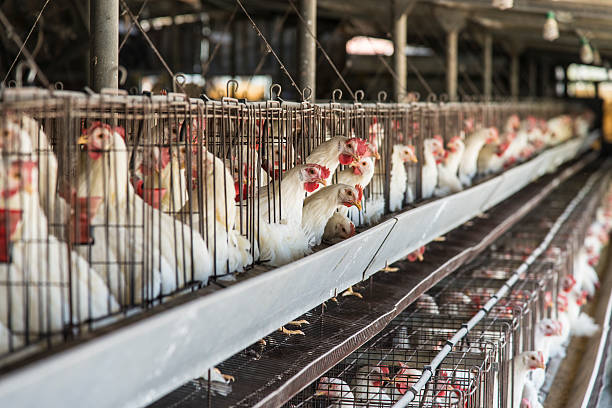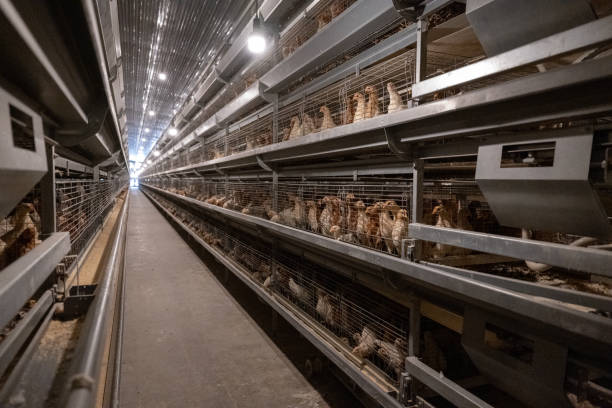
Cost-Effective Brooder Cages: Building a Profitable Poultry Business Plan in Africa
Cost-Effective Brooder Cages: Building a Profitable Poultry Business Plan in Africa

Poultry farming in Africa holds immense potential, offering a source of income, food security, and employment opportunities for many. However, starting and maintaining a successful poultry business requires careful planning, sound investment decisions, and practical knowledge of optimal rearing practices. One of the most crucial initial investments for aspiring poultry farmers, particularly those focusing on broiler production, is the selection and implementation of cost-effective brooder cages. This article explores the significance of brooder cages in establishing a profitable poultry business in Africa, covering various aspects like cage design, materials, management practices, and integration into a comprehensive business plan.
The Significance of Brooder Cages
Brooder cages serve as the primary housing for chicks during their initial weeks of life, typically from day-old to around four to six weeks. This period is crucial as chicks are highly vulnerable to environmental stressors and diseases. Brooder cages provide a controlled environment that helps regulate temperature, protect against predators, and facilitate easy access to feed and water. Investing in quality brooder cages is not simply about providing shelter; it’s about laying the foundation for healthy growth, reduced mortality rates, and, ultimately, a more profitable poultry operation.
Why are brooder cages so vital in the African context? The African climate presents unique challenges to poultry farming. Extreme temperatures, both hot and cold, can significantly impact chick survival and growth. Exposure to predators like rodents, snakes, and even domestic animals poses a constant threat. Moreover, poor sanitation and disease outbreaks are prevalent in many regions. Brooder cages mitigate these risks by creating a secure, easily manageable, and hygienic environment for young chicks.
Types of Brooder Cages and Considerations for Selection
Several types of brooder cages are available, each with its own advantages and disadvantages. When choosing the right option for your poultry business in Africa, consider factors like the number of chicks you plan to brood, available space, budget, climate, and desired level of automation.
Battery Brooder Cages: These are multi-tiered cages often made of galvanized steel wire. They maximize space utilization and are ideal for large-scale operations. Battery brooder cages provide excellent ventilation and allow for easy cleaning and waste management. However, they can be more expensive upfront and may require a more sophisticated heating system, especially in colder climates.
Flat Deck Brooder Cages: These are single-layer cages, often constructed from wire mesh or wooden frames. They are a more affordable option for smaller-scale farmers. Flat deck brooder cages are relatively easy to build and maintain. However, they require more floor space and may not offer the same level of environmental control as battery cages.
DIY Brooder Cages: Many farmers opt to build their own brooder cages using locally available materials like wood, bamboo, and wire mesh. This can be a very cost-effective option, but it requires careful planning and construction to ensure the cage is safe, durable, and provides adequate ventilation and heating.
Considerations for Selecting the Right Brooder Cage:
Climate: In hot climates, prioritize cages with good ventilation to prevent overheating. In colder regions, choose cages that can be easily insulated and heated.
Number of Chicks: Determine the capacity of the cage based on the number of chicks you plan to brood per batch. Overcrowding can lead to stress and increased disease susceptibility.
Budget: Balance the cost of the cage with its durability and functionality. A cheaper option may require frequent repairs or replacements, ultimately costing more in the long run.
Ease of Cleaning and Maintenance: Choose cages that are easy to clean and disinfect. Hygiene is crucial for preventing disease outbreaks.
Accessibility: Ensure that chicks have easy access to feed and water.
Materials for Brooder Cage Construction: Making Cost-Effective Choices
The materials used in brooder cage construction significantly impact the cage’s durability, hygiene, and overall cost. Farmers in Africa often need to be resourceful and utilize locally available materials to minimize expenses.
Galvanized Steel Wire Mesh: This is a popular material for constructing cage floors and sides. It is durable, easy to clean, and provides good ventilation. Galvanized steel is also resistant to rust and corrosion, extending the lifespan of the cage.
Wood: Wood can be used for constructing cage frames and supports. It is readily available in many parts of Africa and is relatively inexpensive. However, wood is susceptible to rot and can harbor bacteria if not properly treated. Pressure-treated lumber is a good option for increasing durability.
Bamboo: Bamboo is a sustainable and affordable material that can be used for constructing cage frames and partitions. It is strong, lightweight, and readily available in many tropical regions. However, bamboo needs to be properly treated to prevent insect infestation and decay.
Plastic Mesh: Plastic mesh is a lightweight and easy-to-clean material that can be used for cage floors and sides. It is resistant to moisture and corrosion. However, it may not be as durable as galvanized steel wire mesh.
Considerations for Material Selection:
Availability: Choose materials that are readily available in your local area to minimize transportation costs.
Cost: Compare the prices of different materials and choose the most cost-effective option that meets your needs.
Durability: Select materials that are durable and resistant to wear and tear, ensuring a long lifespan for your brooder cages.

Hygiene: Choose materials that are easy to clean and disinfect to prevent disease outbreaks.
Sustainability: Consider using sustainable materials like bamboo, which are environmentally friendly and readily renewable.
Managing Brooder Cages for Optimal Chick Health and Growth
Proper management of brooder cages is crucial for ensuring chick health, reducing mortality, and maximizing growth rates. This includes maintaining optimal temperature, providing adequate ventilation, ensuring access to feed and water, and implementing strict hygiene practices.
Temperature Management: Maintaining a constant temperature is crucial for the first few weeks of a chick’s life. Day-old chicks require a temperature of around 32-35°C (90-95°F), which can be gradually reduced by 2-3°C per week until reaching room temperature. Use thermometers strategically placed within the brooder cage to monitor temperature accurately. Heat sources can include incandescent bulbs, heat lamps, or gas brooders. Ensure that the heat source is safely positioned to prevent burns or fire hazards.
Ventilation: Adequate ventilation is essential for removing ammonia, carbon dioxide, and moisture from the brooder cage. Stale air can lead to respiratory problems and increased disease susceptibility. Ensure that the cage has sufficient ventilation without creating drafts. Adjustable vents can be used to control airflow.
Feed and Water Management: Provide chicks with fresh, clean feed and water at all times. Use chick feeders and waterers that are specifically designed to prevent spillage and contamination. Ensure that all chicks have access to feed and water. Monitor feed and water consumption to detect any signs of illness or stress.
Hygiene: Maintaining strict hygiene is crucial for preventing disease outbreaks. Clean and disinfect the brooder cage regularly, removing any droppings or spilled feed. Use a poultry-approved disinfectant. Change the bedding material frequently. Practice biosecurity measures, such as foot baths and hand washing, to prevent the introduction of pathogens into the brooder area.
Lighting: Provide adequate lighting for chicks to find feed and water. A 24-hour lighting schedule is recommended for the first few days, followed by a gradual reduction to around 16 hours of light per day.
Integrating Brooder Cages into a Comprehensive Poultry Business Plan
Investing in cost-effective brooder cages is just one piece of the puzzle when building a profitable poultry business in Africa. A comprehensive business plan is essential for outlining your goals, strategies, and financial projections.
Market Analysis: Conduct thorough market research to identify your target market, understand consumer preferences, and assess the competition. Determine the demand for broiler chickens in your local area.

Production Plan: Develop a detailed production plan that outlines the number of chicks you plan to brood per batch, the duration of the brooding period, and the target weight for the birds at slaughter. Calculate the feed, water, and other resources required.
Financial Projections: Create realistic financial projections that include startup costs, operating expenses, revenue projections, and profitability analysis. Identify potential sources of funding, such as loans, grants, or personal savings.
Marketing and Sales Strategy: Develop a marketing and sales strategy to reach your target market. This may include direct sales to consumers, partnerships with restaurants or retailers, or selling to wholesalers.
Risk Management: Identify potential risks to your poultry business, such as disease outbreaks, fluctuating feed prices, or market volatility. Develop strategies to mitigate these risks, such as purchasing insurance or diversifying your marketing channels.
Sustainability: Incorporate sustainable practices into your poultry business to minimize your environmental impact. This may include using renewable energy sources, implementing waste management strategies, and promoting responsible animal welfare practices.
The Importance of Training and Education: Continuously seek knowledge and training to enhance your poultry farming skills. Attend workshops, seminars, and training programs offered by agricultural extension services or poultry industry organizations. Network with other poultry farmers to share experiences and learn from their successes and failures.
Investing in cost-effective brooder cages and implementing sound management practices are essential for building a profitable poultry business in Africa. By carefully considering cage design, materials, and management techniques, and by integrating brooder cages into a comprehensive business plan, aspiring poultry farmers can lay the foundation for a thriving and sustainable enterprise that contributes to food security and economic development in their communities. Remember, poultry farming is a dynamic field; continuous learning and adaptation are key to long-term success.
